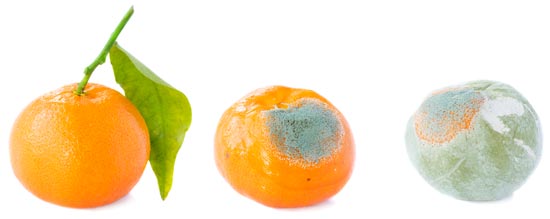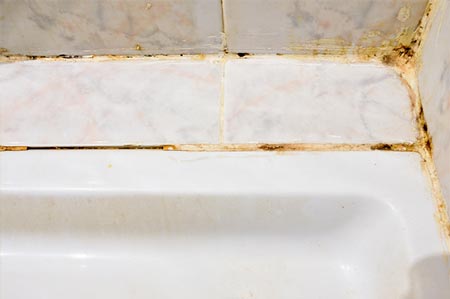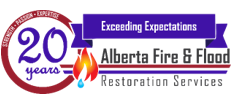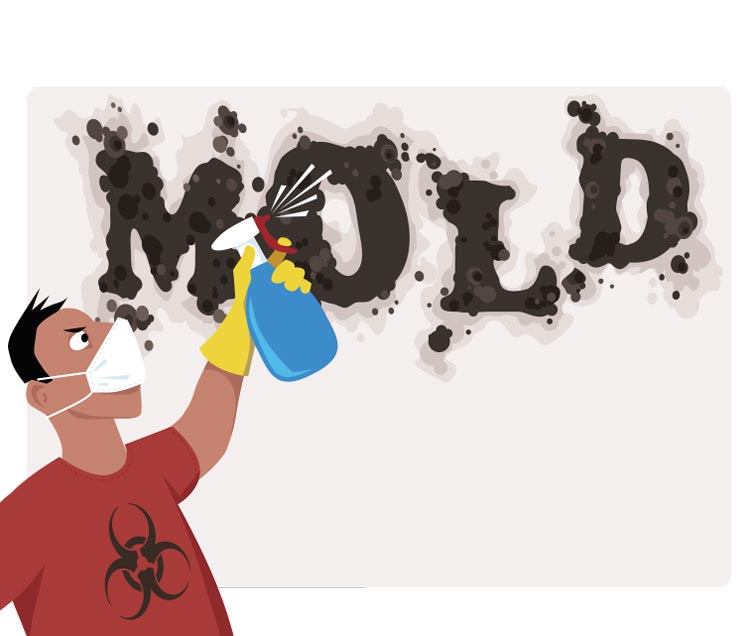Most people know that mould (AKA: “mold”) relies on moisture to grow, but not everyone realizes that even a minor water leak or slightly too much humidity is all that is needed for household mould to take hold – even in drier climates like we have here in Calgary.
Yet while there are many different types of mould that can crop up in your home or workplace, you can be sure of one thing: it should not be there.
Residential mould has been around for as long as, well, residences have existed. Depending on the climate and terrain in which the mould occurs, it can spread quickly (sometimes within the span of a day or two) or it can creep its way into the cracks, crevices, and small crannies of your living and/or work spaces.

Much like mould on a piece of food, once it appears it can progress very quickly.
Alberta Fire & Flood is Calgary’s trusted mould inspection, removal, and remediation company. We have been helping Albertans for decades with mould identification and recovery, and are honoured to be the mould removal specialists of choice for many local long-term care facilities, schools, and professional organizations throughout southern Alberta. Rest assured, you can trust us to address all of your mould infestation concerns.
We’ve created a collection of the top facts you should know about mould in Calgary and southern Alberta, including the most common forms of indoor mould and what to do (and not to do) in treating and sanitizing indoor mould infestations.
1. Most mould is not lethal, but it can certainly cause adverse health effects.
The word “mycotoxins” gets thrown around a lot in the mould remediation business, but what exactly is a mycotoxin?
Mycotoxins are harmful compounds that are naturally produced by moulds, yeasts, and mushrooms. There are two mould species that are mainly responsible for the myctotoxins that most commonly pose a threat to human and animal health: Fusarium and Aspergillus. [1]
According to the NCCEH,
[E]xposure to mould . . . in indoor environments is associated with asthma (both development and exacerbation), upper respiratory tract symptoms, cough and wheeze, hypersensitivity pneumonitis in susceptible people, respiratory infections, bronchitis, and eczema.[2]
While the vast majority of indoor moulds will not produce the kind of mycotoxins that cause serious and long-term health hazards, they can (and often do) cause lung irritation, and allergic & hypersensitivity reactions.
Other things that impact a person’s physiological response to mould include age, health & immune status, simultaneous exposures, and genetic factors.
2. Removing Mould Can Require More Than Just Some Bleach & Elbow Grease.

If you simply have a case of mould growing on the grout of your shower stall then maybe all that is needed is a bleach solution and strong scrubbing. But even then, it’s a wise move to make sure that the excess moisture that caused the superficial grout mould hasn’t permeated into the inside walls of your bathroom(s).
The Government of Canada suggests that you seek advice from a qualified professional to examine the condition of your home for the presence of mould.[3] As experienced Calgary mould removal and remediation professionals, we can give you just as many anecdotes of folks who thought they only had superficial mould but discovered otherwise as we can of folks who really did just have gross grout.
As with many other important things in life: When in doubt, call a professional!
3. Do You Need To Air Test For Mould?
Mould is a natural part of the environment and, as a result, there are always mould spores in the air. As such, any mould spores detected in an air test will not always be indicative of a mould problem in your home.
That said, there are certain specific examples where air testing for mould is absolutely necessary. These examples include:
- Protective environment rooms for individuals who are severely immunocompromised (such as those who have received hematopoietic stem cell transplants)[4]
- Property owners who want to have a “Repair Order”, “Unfit for Human Habitation Order”, or “Notice of Health Hazard” from Alberta Health Services removed. [5]
Outside of that, there are certain things for which an air test for mould can be useful. These things include:
- Whether or not there are elevated levels of mould spores in your environment
- The quality of your indoor air
- The species of mould present
However, an air test for mould will not tell you where to find the mould, how it’s spreading, nor will it tell you the underlying cause of its presence.
4. What Defines a “Small”, “Medium”, and/or “Large” Area of Mould?
When choosing a mould clean up plan, it’s important to know whether you’re dealing with a small, medium, or large area of mould coverage.
Health Canada defines a “small” area of mould as “no more than three patches of mould, with the total area staying within one square metre.” [6]
A “medium” sized area of mould is more than three patches of mould, and where the total combined area is between one and three metres. It is strongly recommended that medium-sized mould patches receive an expert assessment to determine the best mould removal method for dealing with them.
A “large” area of mould is where a single patch of mould is larger than three metres squared. It is important to note that, for your health and safety (and those with whom you reside), “large” areas of mould should be removed by a qualified mould remediation professional (such as Alberta Fire & Flood).
5. Do You Really Have to Physically Remove ALL Mould-Damaged Materials?
Mould removal best practices are that materials damaged by mould are to be safely removed and disposed of, either by you or by a qualified mould removal professional. The only exception to this is if the mould growth is only on smooth, non-porous surfaces (such as tiles).
Any other instances of mould need to be dealt with by physically removing the materials in/upon which it occurs and disposing of them. To do this safely, you will need either a mould removal specialist or to don protective gear in the form of safety goggles, disposable N95 masks, and disposable household cleaning gloves (depending on the situation).
6. How Do You Prevent Mould from Forming?
Because mould is such a tenacious fungus, an ounce of prevention really is worth a pound of cure. There are simple things you can do to prevent the occurrence of mould in your home, which include:
Ventilate:
- Having and using a properly working exhaust fan in areas prone to high humidity/moisture levels, such as the bathroom. Keep this fan running for a minimum of a half hour after finishing a shower or hot bath.
- Ensure that any ventilation is effectively and properly sealed, reinforced, unobstructed, and in good working order.
Repair:
- Repair or replace any open or damaged surfaces, such as linoleum, tiles, grout and caulking, and ceiling stucco.
- Stay on top of your plumbing by promptly repairing any leaks or faulty pipes (improperly remediated water damage is a leading cause of mould infestations!)
- Check that all water drains (sink, bathtub/shower, washing machine, dishwasher, etc.) are draining properly.
Condensation:
- Keep the walls of your bathroom dry and clean. You can do this with a clean, basic towel or a squeegee.
- Keep your curtains, blinds, and shutters open in order to allow air to flow freely – window coverings could trap moisture and create condensation on and around the windows.
Everything Else:
- If you have a particularly moisture prone or humid area in your home then consider using a dehumidifier there.
- Keep all areas (including storage) free of clutter and debris.
- Store firewood outside.
- Remove footwear upon entering the home.
- Vacuum frequently using a HEPA filtered vacuum.
Hopefully this article has helped improve your understanding of mould, its causes, health impacts, as well as given you insight into the best practices for mould removal and remediation. If you have any questions, or if you would like to talk to an expert about your specific mould-related concerns, then please feel free to contact us here at Alberta Fire & Flood! One of our mould removal experts would be happy to help you in whatever way we can.
[1] https://www.greenfacts.org/en/mycotoxins-aflatoxins-fumonisins/l-2/index.htm
[2] https://www.ncceh.ca/sites/default/files/Mould_and_Health_Effects_Jul_2012.pdf
[3] https://www.canada.ca/en/health-canada/services/publications/healthy-living/addressing-moisture-mould-your-home.html
[4] https://www.albertahealthservices.ca/assets/healthinfo/ipc/hi-ipc-immunocompromised-patients.pdf
[5] https://www.albertahealthservices.ca/assets/wf/eph/wf-eh-fungal-air-testing-for-mould-contaminated-buildings.pdf
[6] https://www.canada.ca/en/health-canada/services/publications/healthy-living/addressing-moisture-mould-your-home.html

